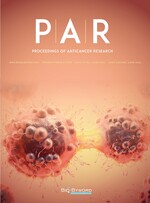Abstract
Objective: To analyze serum vitamin D levels in patients with clear cell renal cell carcinoma (ccRCC) by flow cytometry and to investigate the relationship between hypovitaminosis D status and hyperactivation of IL-6/STAT3 signaling in ccRCC. Methods: Eighty patients diagnosed with ccRCC by our oncology department from January 2019 to December 2021 were selected as study subjects, and the control subjects were selected from patients who were receiving health check-up from our hospital (matched according to case group:control group, 1:2), with 160 healthy patients. All serum samples collected from the case-control subjects were allowed to stand for 1–2 hours, centrifuged at 3000 rpm for 10 minutes, and stored in a -80°C refrigerator, from which they were removed and thawed to measure 25-hydroxyvitamin D (25(OH)D) and interleukin 6 (IL-6) levels. Results: The blood calcium level of patients in the cancer group was significantly lower than that of patients in the non-cancer group, and the difference was statistically significant (P < 0.05). The IL-6 level of the cancer group was significantly higher than that of the non-cancer group. In high vitamin D state, the IL-6 level of the non-cancer group was higher than that of the cancer group, and the average concentration of IL-6 in both the cancer group and the non-cancer group was significantly higher in low vitamin D state compared with high vitamin D state (P < 0.05); the correlation between hypovitaminosis D status and renal Ki-67 was found to be positive. Conclusion: The results showed that serum IL-6 levels were elevated in the cancer group and circulating serum 25(OH)D levels were negatively correlated with IL-6 levels. In addition, signal transducer and activator of transcription 3 (STAT3) signaling in RCC tissues was activated in ccRCC patients and in those with low vitamin D status among the cancer group and was higher than that in those with high vitamin D status. These results suggest that hypovitaminosis D status in ccRCC patients is associated with activated IL-6/STAT3 signaling and the activation of tumor proliferation markers proliferating cell nuclear antigen (PCNA), cyclin D1, and Ki-67.
References
Li F, Huo D, Luan S, et al., 2021, Role of IL-6/JAK2/STAT3 Signaling Pathway in Tumors. Chemistry of Life, 41(03): 535–540.
Han X, Xi Z, Wang K, et al., 2020, In Vitro Experiments on the Regulation of IL-6/STAT3 Signaling Pathway by Hairy Crotonine to Inhibit Proliferation, Migration and Induce Apoptosis in Colon Cancer Cells. Chinese Journal of Gerontology, 40(18): 3955–3959.
Xu S, 2020, Partial Mechanism of Vitamin D3 Inhibition of Epithelial-Mesenchymal Transition and Migration Invasion in Renal Cell Carcinoma, thesis, Anhui Medical University.
Di W, 2019, Study on the Function and Mechanism of E3 Ubiquitin Ligase HECTD3 in Renal Clear Cell Carcinoma, thesis, Kunming University of Science and Technology.
Song J, 2019, Correlation Between Serum Hypovitaminosis D Status and Excessive Activation of Renal IL-6/STAT3 Signaling in Patients with Renal Clear Cell Carcinoma, thesis, Anhui Medical University.
Liu B, 2015, Expression and Correlation of Carbonic Anhydrase IX and PTEN Protein in Renal Clear Cell Carcinoma, thesis, Anhui Medical University.
Gao Y, 2015, Study on the Mechanism of CREPT in Renal Clear Cell Carcinoma, thesis, Ningxia Medical University.
Lian J, 2014, Expression of microRNA-122 in Renal Clear Cell Carcinoma Tissues and the Study of Molecular Regulatory Mechanism in Renal Clear Cell Carcinoma Invasion and Metastasis, thesis, Jilin University.
Li R, 2013, Preliminary Study on the Relationship Between SCIN and Proliferation of Renal Clear Cell Carcinoma, thesis, Kunming Medical University.
Yang Y, 2013, Expression of miR-145 in Kidney and Bladder Cancers and Its Preliminary Functional Study, thesis, Huazhong University of Science and Technology.
Cai Y, Huang Y, 2012, CT and MRI Manifestations of Renal Clear Cell Carcinoma. Chinese and Foreign Medical Science, 31(07): 181 + 183.
Fitch N, Becker AB, 2016, Vitamin D [1,25(OH)2D3] Differentially Regulates Human Innate Cytokine Responses to Bacterial Versus Viral Pattern Recognition Receptor Stimuli. Journal of Immunology, 196(7): 2965–2972.
Colotta F, Jansson B, Bonelli F, 2017, Modulation of Inflammatory and Immune Responses by Vitamin D. J Autoimmun, 85: 78–97.
Powe CE, Evans MK, Wenger J, et al., 2013, Vitamin D-Binding Protein and Vitamin D Status of Black Americans and White Americans. N Engl J Med, 369(21): 1991–2000.
Chen YH, Fu L, Hao JH, et al., 2015, Maternal Vitamin D Deficiency During Pregnancy Elevates the Risks of Small for Gestational Age and Low Birth Weight Infants in Chinese Population. J Clin Endocrinol Metab, 100(5): 1912–1919.
